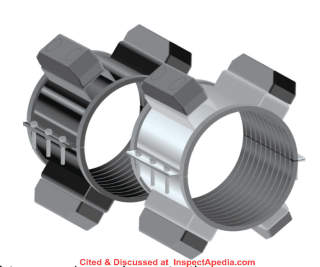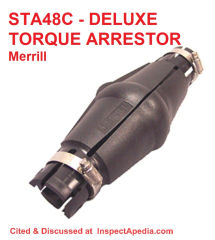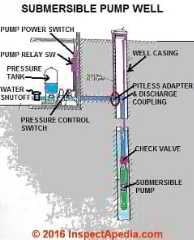 Submersible Well Pumps Torque Solutions
Submersible Well Pumps Torque Solutions
Stop damage & pump losses due to twisting of the submersible pump
- POST a QUESTION or COMMENT about submersible well pump & pump controls, their properties, installation, troubleshooting & repair
Submersible well pump torque problems & solutions:
Here we explain how to use a torque arrestor & other methods to stop damage to well pump wiring & piping caused by twisting forces as the pump starts.
This article series describes the components of a submersible well pump water system, how the pump, well and controls work, what the well pump components look like, and what they do. We give submersible well pump troubleshooting advice and invite questions. We include definitions of water well and water well drilling terms, the typical capacity of drilled water well pumps, and we include descriptions of methods used to fish materials out of a water well if you've dropped the pipe, well pump, or tools down into the well casing.
InspectAPedia tolerates no conflicts of interest. We have no relationship with advertisers, products, or services discussed at this website.
Submersible Pump Torque Problems: loose connections, damaged piping, damaged wiring, lost pumps & Pipes
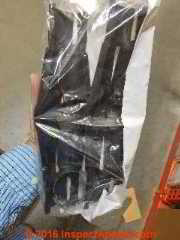 Question: how to stop the submersible pump from un-screwing its pipe connections
Question: how to stop the submersible pump from un-screwing its pipe connections
2016/08/15 Rodney said:
The submersible pump keeps unscrewing itself even after I glued the threaded coupler. I have to pull it out a 3rd time now. How can I make sure this doesn't happen again. Or is there a more serious problem at hand?
It has great pressure and it works great but right about on the 3rd or 4th day the pump quits I'm sure it's the same thing. I'll know for sure when u pull it tomorrow.
This question was posted originally at PUMP PRIME, REPEATED LOSS OF
Reply: Solutions for submersible pump well piping torque problems: unscrewing the pump, piping breaks, wiring damage, casing damage, lost pumps, lost piping.
Rodney:
I suspect that a torque produced when the pump starts is the cause of this un-screwing of the coupler. The rotating torque produced when the submersible well pump turns on tends to rotate the pump in a direction that un-screws the coupling to the drop pipe. The higher the submersible pump horsepower the greater the starting torque or twist motion forces will be.
This same rotating torque can, if the well piping is not centered in the well casing an bore, abrade the well piping ultimately causing it to break or leak. A well pipe slapping around in the well will also damage electrical wiring descending to the well pump.
Finally, the torque imparted by a starting submersible pump can also twist well piping so that that force along leads to pipe breakage, especially when PVC well piping is used.
Approaches to Handling Well Pump Torque Problems
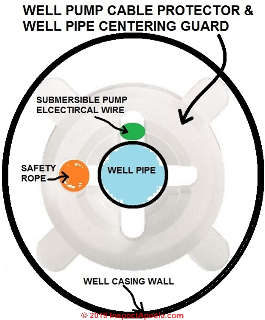 Well and plumbing experts address the well piping torque problem using several approaches. We discuss these in more detail below.
Well and plumbing experts address the well piping torque problem using several approaches. We discuss these in more detail below.
- Keep the well piping centered
in the well using spacers like the well pump cable protector shown here. This helps avoid pipe and wire abrasion damage. - Use a torque arrestor
at the pump and at intervals on well piping. Synonyms for well pump torque arrestor: "football type torque arrestor" or TA-48.
A torque arrestor clamps onto the well piping above the pump, fitting1" to 1 1/4" diameter well pipes and expandable to work inside of well casings from 4" to 8" in inside diameter.
Additional torque arrestors are installed at 75 to 100' intervals on the piping inside the well. Details are given below on this page.
Depending on where you live, local plumbing codes may require the use of torque adapters on submersible pump installations. - Use welded pipe
sections and metal piping to resist pipe breaks and damage - Watch out: If your pump is short-cycling for other reasons such as a waterlogged pressure tank, starting more often than needed, the torque problem will be multiplied, increasing the risk of repeated breaks in well piping.
- For high horsepower submersible well pumps, use an electrical controller that slowly spins-up the submersible pump motor to full speed.
Watch out: some spin-up controllers may, however, cycle so frequently that that system may itself damage the well pump motor shaft or well piping.
So, Rodney, you may have to use welded iron pipe to resist pipe breakage due to torque forces.
But in the photos above and below I'm showing another possibility that will work on some submersible well pump systems: a rubber pump torque arrester produced by Everbilt (and a number of other suppliers too) and sold at plumbing and building suppliers.
Torque Arrestor Installation Instructions
This photo was taken in a New York Home Depot store where the Everbilt Torque Arrestor sells for under $15.00. The part number is 1001 098 335. Everbilt torque arrestors are made in Canada and sold across North America. Similar products are sold in other countries.
This rubber torque arrestor device attaches around the well piping and then is expanded so that its rubber rib is just snug against the interior of the well casing.
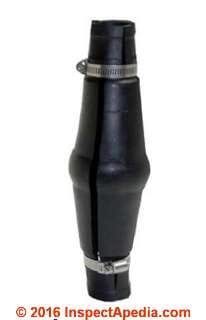 The torque arrestor, by pressing against the well casing sides, is designed to absorb and dampen the twisting torque motion imparted by the submersible pump at the start of a pump-on cycle (a similar force may occur at the end of a pump on cycle too).
The torque arrestor, by pressing against the well casing sides, is designed to absorb and dampen the twisting torque motion imparted by the submersible pump at the start of a pump-on cycle (a similar force may occur at the end of a pump on cycle too).
The rubber torque arrester shown fits inside of well casings from 4" to 8" in diameter. Below we show the submersible pump torque arrestor assembled.
Some wells may need multiple torque arrestors depending on well depth.
Here is a slightly edited version of what Merrill Manufacturing™, a manufacturer of torque arrestors says about installing these devices:
The first torque arrestor should be placed no more than 3' above the pump, near the bottom of the well.
Use additional rubber torque arrestors at intervals of 75' to 100' along the rising well pipe above the first torque arrestor.
Place the torque arrestor around the drop pipe so that each half is spaced evenly.
Install the lower pipe clamp and tighten.
Install the upper pipe clamp (leave loose) and then push down on the torque arrestor to spread the center portion so it fits the inside of the casing.
Watch out: the object is to expand the torque arrestor outwards from the well pipe so that it fits snugly against the inside of the well casing, but don't expsnd it so much that you cannot push the assembly down into the casing. Don't over-do it.
Just a snug fit, do not spread it so much that it is hard to get it in the casing.
Then tighten the upper clamp.
Watch out: It is very important that the upper clamp is as tight as possible. This will make it easier to remove the pump at a later date.
Note: some sources suggest that you shoudl be sure to tighten the upper clamp on the torque arrestor to 60 inch-pounds. If the torque arrestor upper clamp is too loose, when next attempting to install the new assembly or later when you try to pull the well piping and pump you'll find that the whole assembly slides up or down the well piping.
- source; "Torque Arrestor Installation", Merrill Manufacturing, 315 Flint Drive PO Box 392 Storm Lake, IA 50588-0392 800-831-6962 retrieved 2016/09/22, original source: https://www.merrillmfg.com/product/torque-arrestor-installation - with edits and expansion from other sources.
Note: other sources suggest placing the bottom edge of the first torque arrestor at least 18" above the submersible pump and no more than 24" above the pump assembly.
Watch out: don't spread the torque arrestor so that it fits more than just snug in the well casing or you may later have trouble inserting or removing the well piping from the well.
Other Opinions about Torque Arrestors
Really? Some plumbing experts gripe that these torque arrestors don't work well and cause trouble later when you are pulling well piping. Also, bits of debris, gravel, sand, rust flakes falling down the well bore and resting on the upper rim of the torque arrestor may cause it to jam in the well casing.
Above in this discussion we include warnings about proper placement and tightening of the torque arrestor clamps to avoid slipping on the well piping, and a warning not to over-expand the torque arrestor so that it might jam in the well casing.
Well Pipe Centering in the Casing
A second function of the torque arrestor is to keep the well piping centered in the well. This can be a problem if the well bore is not straight or if the well piping flops around in the well casing when the pump starts.
Other devices are sold for centering well piping: you don't have to use a torque arrestor just for that purpose.
All well experts do advise, however, that you use centering spaces to keep well piping centered in the well casing. Otherwise movement of the well piping in the casing is likely to lead to wear, piping leaks, and possibly well casing damage.
In deeper wells or with heavier pumps welding the pipe connections may be required to manage pump torque.
Routing & Protection of Well Pump Wiring & Safety Rope
Watch out: be sure to secure both the pump's electrical wiring and the safety rope outside of the torque arrestor routed through other well pipe centering fittings so that if the well pipe arrestor clamp comes loose it won't contact, cut, or damage the wiring or safety rope.
Well Pump Torque Properties
Here is what Franklin Water says about pump torque:
During starting of a submersible pump, the torque developed by the motor must be supported through the pump, delivery pipe or other supports.
Most pumps rotate in the direction which causes unscrewing torque on right-handed threaded pipe or pump stages.
All threaded joints, pumps and other parts of the pump support system must be capable of withstanding the maximum torque repeatedly without loosening or breaking.
Unscrewing joints will break electrical cable and may cause loss of the pump-motor unit.
Now for the kicker:
To safely withstand maximum unscrewing torques with a minimum safety factor of 1.5, tightening all threaded joints to at least 13.57 N-m per motor horsepower is recommended (Table 2A).
It may be necessary to tack or strap weld pipe joints on high horsepower pumps, especially at shallower settings. - Source: 50Hz Submersible Motors, Application, Installation, Maintenance [PDF], Franklin Electric Co, Tel: 800-348-2420, Retrieved 2016/08/15, original source: franklinwater.com/media/123156/50_HZ_AIM.pdf
Pump Torque Control References, Instructions, Research
- Boshart Industries, TA-48 SERIES STANDARD SUBMERSIBLE TORQUE ARRESTOR [PDF] Boshart Industries, 25 Whaley Ave , Milverton, ON N0K 1M0 Canada, Tel: 800.561.3164 Web: boshart.com - retrieved 2023/08/24, original source: boshart.com/wp-content/uploads/product-assets/8765abc0fd65890a3f1b6fcb7a6c90602831acf8_TA_48_Standard_Submersible_Torque_Arrestor.pdf
- Boshart Industries, 7 STEPS to SUCCESSFULLY INSTALLA a TORQUE ARRESTOR [PDF] Boshart Industries, 25 Whaley Ave , Milverton, ON N0K 1M0 - retrieved 2023/08/24, original source: https://blog.boshart.com/7-steps-successfully-install-torque-arrestor
- [2] DEEP WELL JET PUMPS PDF, Government of Alberta, Agriculture and Rural Development, toll free in Alberta at 310-FARM web search 07/24/2010, original source: http://www1.agric.gov.ab.ca/$department/deptdocs.nsf/all/agdex639
- [3] Betta-Flo JET PUMP INSTALLATION MANUAL [PDF], National Pump Co., LLC., includes helpful well pump troubleshooting tips as well as basic jet pump installation details. Web search 07/24/2010, original source: http://www.nationalpumpcompany.com/Documents/OIM/Betta%20Flo%20IOM%20Jet%20Pump.pdf
- CCI Piping Systems CASING SPACERS & END SEALS [PDF] (catalog) include polyethylene casing spacers that keep piping centered in the well casing. CCI Piping Systems, 1026 O'Neal Dr., Breaux Bridge LA 70517 USA, Email: sales@ccpipe.com Tel: 8000-867-2772, Web: ccipipe.com provides pipe protection products.
- Farwest Corrosion Control Co., 12029 Regentview Ave Downey, CA 90241 P USA Tel: 888 532-7937 - Web: farwestcorrosion.com - provides PSI Casing Spacers for well piping & casings (310) 532-9524 - HQ (310) 420-5773 - Emergency EMAIL sales@farwestcorrosion.com
- Garlock, offices world wide, Web: garlock.com provides High density, injection molded virgin polyethylene casing isolators/spacers designed primarily for smaller diameter steel or polyethylene carrier pipes. New York: +1 (800) 448-6688
- Merrill, TORQUE ARRESTOR INSTALLATION INSTRUCTIONS [PDF] (2015) Merrill Manufacturing, 315 Flint Drive PO Box 392 Storm Lake, IA 50588-0392 800-831-6962 retrieved 2016/09/22, original source: merrillmfg.com/product/torque-arrestor-installation [Dead Link in 2023 - ed]
- [8] Water Ace Jet Pump Installation Manual, instructions from Water Ace Pump Co., web search 08/28/2010, original source: waterace.com/pdf/R510%20R520%20and%20R100%20Jet%20Pumps%20Manual.pdf
Consumer hotline: 800-942-3343 - instructions for the installation and maintenance of Water Ace shallow well pump Model R510 1/2 HP, Water Ace deep well pump Model R100 convertible 1HP and
Water Ace deep well jet pump Model R250 convertible 1/2 hp.
- [9] Water Ace Jet Pump Installation Manual, from Water Ace Pump Co., web search 08/28/2010, original source: waterace.com/pdf/RTS5%20RTS7%20RTS10%20RC5%20and%20RC10%20Jet%20Pumps%20Manual.pdf
Consumer hotline: 800-942-3343 - instructions for the installation and maintenance of Water Ace pump models:
Water Ace Shallow Well 1-line Jet Pump Models RTS5 (1/2HP), Model RTS7 (3/4 HP) and RTS10 (1HP)
Water Ace Deep Well 2-line Jet Pump Models RC5 (1/2 HP) and RC10 (1HP) - [10] Water Ace Submersible Well Pump Installation Manual, from Water Ace Pump Co., Web: waterace.com, web search 08/28/2010, original source: waterace.com/pdf/23833A019%20Well%20Pumps%20Eng.pdf
Spanish and French language submersible well pump installation manuals are available from the company.
Consumer hotline: 800-942-3343 - instructions for the installation and maintenance of Water Ace pump models: - [11] "Overshot Definition", OilGasGlossary.com. Oil & Gas Field Technical Terms Glossary, Web Search 04/21/2012, original source: http://oilgasglossary.com/overshot.html
- [12] Logan Oil Tools, Inc., 11006 Lucerne Street, Houston, Texas 77016-1920, Tel: 281.219.6613 | Fax 281.219.6638 Email: sales@loganoiltools.com, Website: http://www.loganoiltools.com/
- [13] AGE water well equipment, including AGE Riserless Pump Systems, AGE Developments, 38 Harris Road Malaga WA 6090 Australia, Tel: (08) 9209 2844, Website: agedevelopments.com.au
- Access Water Energy, PO Box 2061, Moorabbin, VIC 3189, Australia, Tel: 1300 797 758, email: sales@accesswater.com.au Website: http://www.accesswater.com.au/
Moorabbin Office: Kingston Trade Centre, 100 Cochranes Rd, Moorabbin, VIC 3189
...
Continue reading at PUMP, SUBMERSIBLE OPERATION or select a topic from the closely-related articles below, or see the complete ARTICLE INDEX.
Or see these
Recommended Articles
- DRILLED WELLS, STEEL CASINGS
- WATER PUMP, SUBMERSIBLE - home
- TWO LINE JET PUMP
- DIAGNOSTIC TABLE for WATER PUMPS
- WATER PRESSURE PROBLEM DIAGNOSIS TABLE
- WATER PUMP WIRING DAMAGE
Suggested citation for this web page
SUBMERSIBLE PUMP TORQUE PROBLEMS & SOLUTIONS at InspectApedia.com - online encyclopedia of building & environmental inspection, testing, diagnosis, repair, & problem prevention advice.
Or see this
Ask a Quest
INDEX to RELATED ARTICLES: ARTICLE INDEX to WATER SUPPLY, PUMPS TANKS WELLS
Or use the SEARCH BOX found below to Ask a Question or Search InspectApedia
ion or Search InspectApediaTry the search box just below, or if you prefer, post a question or comment in the Comments box below and we will respond promptly.
Search the InspectApedia website
Note: appearance of your Comment below may be delayed: if your comment contains an image, photograph, web link, or text that looks to the software as if it might be a web link, your posting will appear after it has been approved by a moderator. Apologies for the delay.
Only one image can be added per comment but you can post as many comments, and therefore images, as you like.
You will not receive a notification when a response to your question has been posted.
Please bookmark this page to make it easy for you to check back for our response.
Our Comment Box is provided by Countable Web Productions countable.ca
Citations & References
In addition to any citations in the article above, a full list is available on request.
- In addition to citations & references found in this article, see the research citations given at the end of the related articles found at our suggested
CONTINUE READING or RECOMMENDED ARTICLES.
- Carson, Dunlop & Associates Ltd., 120 Carlton Street Suite 407, Toronto ON M5A 4K2. Tel: (416) 964-9415 1-800-268-7070 Email: info@carsondunlop.com. Alan Carson is a past president of ASHI, the American Society of Home Inspectors.
Thanks to Alan Carson and Bob Dunlop, for permission for InspectAPedia to use text excerpts from The HOME REFERENCE BOOK - the Encyclopedia of Homes and to use illustrations from The ILLUSTRATED HOME .
Carson Dunlop Associates provides extensive home inspection education and report writing material. In gratitude we provide links to tsome Carson Dunlop Associates products and services.


